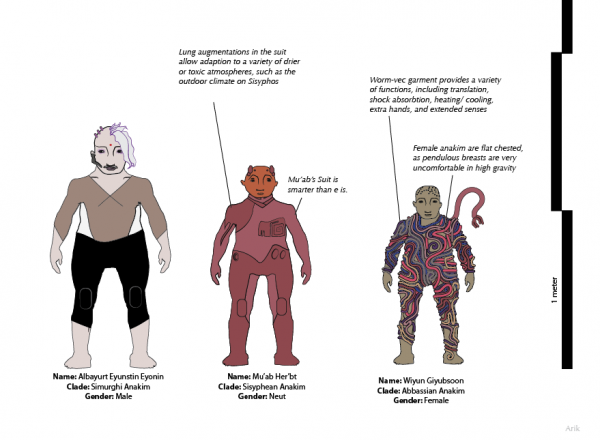BY LETTER
Anakim
The Anakim are a common type of tweak that is adapted for higher than earth-normal gravity. One of the first worlds populated by Anakim-tweaks was Abbas, a superterrestrial world in Horologium, colonised in 2140. There are many variants but all are similar in appearance and capabilities. They were originally designed to settle mineral-rich worlds with unusually deep atmospheres, but their numbers have expanded enough and they have developed sufficiently to qualify them for full Clade status.
The Anakite height range is the same as that of baseline humans including gender differences, and Anakim share the same range of pigmentation as baselines. A typical Anakite masses 150-200 kg. -- females have slighter frames, but not by much. The females are also flat-chested; pendulous breasts are very uncomfortable in high gravity. A much larger (compared to baselines) percentage of body mass consists of skeletal tissue; an Anakite's bones are both thicker and denser than those of baselines. The Anakite frame is also very heavily muscled. Preteen Anakim are over 50% stronger than the average baseline adult, while a full-grown Anakite can lift almost twice eir own weight over eir head in standard gravity. Anakite physiology is adapted to withstand both high gravity and high ambient pressure. They are comfortable in environments ranging from 1.2-2.5G and 1.5-3.5 atmospheres. In fact few terrestrial planets have been found anywhere with surface gravity in excess of this value. Other clades, such as the Kobolds of Sisyphos, are similarly adapted for such extreme conditions, but the Anakim are the most widely distributed.
 Image from Steve Bowers | |
| Abbas; a high gravity Anakite World with a dense N/O/water vapour atmosphere) | |
This clade has some interesting adaptations specific to reproduction in high gravity. Female Anakim have highly elastic muscles and connective tissues in the hips and thighs as well as added articulation in the pelvic bones to create a wider birth canal. Even this wouldn't accommodate the skull of an Anakite infant if not for the flexibility of newborn heads. Baby Anakim have skulls consisting of small bony plates affixed to a cartilaginous matrix. This arrangement resists compression that would damage the brain while remaining flexible enough to squeeze through an opening smaller than the diameter of the uncompressed skull. A newborn's skull "sets" to a harder consistency a few hours after birth and solidifies completely within a month. The testes of male Anakim are normally retracted into the pelvis, where body heat inhibits sperm production. Anakite men have monthly seminal cycles during which the testes descend and begin making sperm. All of the above adaptations,singly or in combination, have been observed in other high gravity species.
Anakim have some important limitations. They are prone to vertigo when in (to them) low pressure environments. Most Anakim wear respirators when traveling in areas where the ambient pressure is less than 1.5 atmospheres. They also lack the agility necessary for activities like gymnastics -- not surprising for beings who are all muscle-bound -- but are surprisingly good dancers if the music is slow. The unaugmented lifespan is about 10% shorter than that of baselines under optimal conditions, and those who spend a lot of time in standard gravity tend to die even younger. This is due to hypertension brought on by the enhancements to the cardiac muscle needed to pump blood against higher than standard gravity. Advanced medical techniques -- when they are available and for those who can afford them -- can mitigate or eliminate these shortcomings.
The most unusual feature of Anakim is psychological rather than physical; they have a powerful fear of heights. This might seem pathological to those who are used to standard gravity, but such a fear is perfectly reasonable for high-gravity natives. On most Anakite-settled worlds a fall from as little as eight meters is usually fatal. The Anakite fear of falling also extends to having things fall on them. This is why they move so carefully; they are equally anxious about falling and about knocking things over. Not wanting to be the target of a falling object makes many Anakim as nervous about being at the bottom of a long drop as they would be looking down from the top of it. Their own architecture uses space horizontally rather than vertically, with low ceilings and lots of load-bearing members.
Anakim are fairly common throughout the Civilized Galaxy and in hu- friendly polities on the fringes of terragens space. They normally conform to the local cultures of whatever polities they live in but will form separate communities rather than integrating fully. The most common living arrangement is an extended family or clan. The necessity of synchronizing menstrual and seminal cycles in order to reproduce creates a tendency toward stable relationships. Most Anakim would rather marry than sleep around, but they are equally likely to be monogamous or polygamous. Group marriages are not uncommon.
Anakim are much in demand as crew on relativistic ships because their tolerance for high gravity allows them to withstand high acceleration. A ship whose entire crew is grav-tolerant can accelerate faster than the competition and reach the destination first. Anakim aren't as gifted in this regard as artificials but they can easily outperform most other bionts. Many clans exploit this fact to become successful trading Houses. There are even Anakite clan-ships on which entire generations live and die without ever setting foot on a planet's surface. These ships spend as much time as possible under acceleration, often arranging for the next trip before reaching the current destination and always on the lookout for the next chance to "get heavy."
Related Articles
Appears in Topics
Development Notes
Text by Michael Walton
Initially published on 26 August 2004.
Initially published on 26 August 2004.







